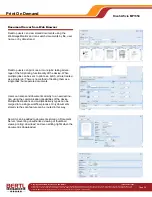
Copyright © 2006 MCA Internet, LLC dba BERTL.
13 November 2006
All Rights Reserved. The license under which this document is made available and applicable law prohibit any reproduction or further transmission of any portion of this document. This
document may only be viewed electronically through the www.BERTL.com Web site and may not be stored in electronic or hard copy format. Any reproduction of trademarks is strictly
prohibited. BERTL accepts no responsibility for any inaccuracies or omissions contained in this document.
Page 25
Ricoh Aficio MP1350
Market Background Information:
Ever since MFPs started including hard
drives, manufacturers have looked for ways to
offer more and more on-demand document
facilities.
The most basic is the ability to store a document on the
device for instant reprinting from the walk-up interface. Vir-
tually all manufacturers offer this level of print-on-demand
capability. Most allow users to store, copy, and print. Some
also include scan and fax documents into the mix.
Are All Documents the Same?
The way different document function types are stored and
the way in which they can be reused at a later date create
some issues due to the file format in which the function
operates. Copy is usually done in a compressed proprie-
tary format, fax in TIFF, and scan in TIFF/PDF or JPEG as
selected by the user.
When users look to reuse the files, they are often limited to
the same function as it was created in.
Do All Devices Offer the Same Capabilities?
There is much differentiation between products and manu-
facturers in this area. Those interested in print on demand
should look carefully at the functionality offered by each
manufacturer.
Areas of differentiation include the range of finishing or out-
put control the user can place upon a reprint-on-demand
job; whether more than one stored job can be combined
and treated as a single print file; the ability to view, manage
and share stored documents using desktop applications;
the complexity of the filing system in place; and the ease at
which users can search for documents.
The Future
Increasing security concerns may result in more compa-
nies using data overwrite kits. This would put an end to the
print-on-demand capability of such devices. For those still
looking for a fast reprint capability, the answer may be ex-
ternal media ports such as USB memory sticks, digital
camera SD cards, or volatile memory storage.
Ricoh has been an innovator and leader in the field of
print on demand in MFPs for many years, ever since the
introduction of its Document Server technology. The
Document Server takes advantage of the large hard drive
storage facility providing walk up, desktop, and remote
users with the ability to store documents for future use.
While some manufacturers are introducing their first print-
on-demand capability, Ricoh is now several generations
deep into print on demand. This is a factor that shows as
soon as you start to use the feature.
Documents can be stored in any of the four core
functions of the device: Copy, Print, Document Server,
and Scan. The Copy and Print modes store documents in
a proprietary image format that allow the files to be
reprinted at the device. The documents cannot be
forwarded or scanned to other destinations unless they
are converted from the proprietary file format with Ricoh’s
file format converter.
Scan, however, stores documents in industry standard
TIFF and PDF that allows the files to be forwarded
instantly either by a walk-up user or a desktop user. This
valuable feature allows commonly used large documents
to be sent out without the user having to reprocess the
document. This saves time and money.
Documents can be stored with 1) a generic name
generated by an automated naming convention by the
device itself, 2) a name entered by the user at the time of
saving using the QWERTY keypad. Files stored on
Document Server can also be renamed at any time after
storage using the Web Image Server or DeskTopBinder
utilities. Documents can also be stored with a user name,
further aiding the search process. Users are unable to
store documents with finishing attributes within Document
Server. Instead, they must add the finishing features to
the job when they choose to reprint the file.
Documents can be viewed and reprinted using the large
color touch screen or can be viewed and reprinted from
the desktop using either the WebImageMonitor or Ricoh’s
desktop utility DeskTopBinder. From any of these access
points, users can view thumbnails of the images, thus
eliminating printing the wrong document. This is a risk
with generic file format processes.
Document Server also allows users to merge multiple
documents together to create a single print job that can
be printed with finishing applications. Users are even able
to create multi-document batch workflows (see batch
printing for more details). Permission levels can also be
applied to individual documents providing users with no
access, read only, or edit capabilities as required.
Print On Demand
















































